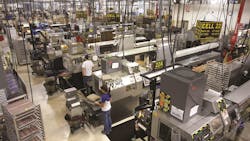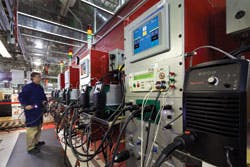What does the discerning manufacturing professional do when stuck in traffic on a California highway? He observes.
He watches how the traffic flows -- or doesn't flow when gridlock has vehicles packed bumper to bumper. He notes the antsy driver who can't bear to wait -- the one who pulls out into a left-hand lane and tries to fly by everybody, only to swerve back to his right at the last possible moment, further tying up traffic behind him.
He wonders whether a squirrel ran across the highway three miles ahead and that is why he is at a standstill.
He applauds traffic patterns and flow that encourage smart and efficient road use.
If that manufacturing professional is David Verhoff, president of Ideal Products Co., an Oshkosh, Wis.-based machine shop, he also sees the similarities between highway traffic and machine shop operations.
See Also: Manufacturing Innovation & Product Development Strategy
For example, Verhoff recognizes that the antsy driver tying up traffic is analogous to a machined item that must be expedited to a customer because it fell behind schedule in the shop. While expediting the piece gets it to a customer when it needs to be there, the act of swerving in front of another scheduled job now jams up the works.
He recognizes that such visual management tools as solid yellow lines and the dotted lines down the middle of the road are widely recognized and communicate standards of behavior.
"There are a lot of lessons about flow to be learned just from watching traffic on the highway," Verhoff says.
The company president keeps those lessons in mind when he relocates his facility, as Verhoff did recently with Ideal Products. The move provided the manufacturer with an opportunity to build a better plant layout, one with improved flow that produces greater efficiency.
It's a challenge every manufacturer faces -- creating a workplace that is efficient, effective and assures that customers' needs are met. Good design applies to more than product appearance and performance. On the plant floor, it can be the difference between delivering a product on time and losing a customer.
Machine Shops Can Flow
"There is pretty universal acceptance that job shops can't flow," says Doug Bengson, president of Headwaters Excellence Partners, Oshkosh, and former manufacturing specialist with the Wisconsin Manufacturing Extension Partnership.
But, he adds, it is simply not true.
Bengson says the acceptance, or assumption, is based on what he calls "traditional barriers" to better job shop layout in high-mix, low-volume environments. Those seeming barriers include the hundreds -- perhaps more -- of unique parts traveling in different directions, which can obscure the ability to observe flow.
In addition, for many operators in a high-mix, low-volume environment, grouping those hundreds of parts into a manageable number of product families can be daunting given the unique nature of each piece. Factor in the number of shared machines and the idea of creating flow flies out the window.
Not for Ideal Products' Verhoff, who cites his reading of the late Eliyahu Goldratt's "The Goal: A Process of Ongoing Improvement" as prompting some of his early thinking on flow. Verhoff recognizes that despite the high variability of parts, underlying similarities among them are not that hard to identify.
And not for Bengson, either, who says better flow can shorten lead times, increase capacity and "lessen the chaos."
"Job shops take a lot of communication," he says.
Making Flow Happen at Ideal Products
What were key processes to making the new layout happen at Ideal Products? They included a cross-functional team approach. The team was comprised of Verhoff and representatives from logistics, scheduling and customer service, as well as several machine operators.
The team outlined challenges with the current plant layout and developed objectives for the new plant layout, explained Bengson, who has been working with Ideal Products on improvement efforts. Those objectives included increased velocity, less work-in-process inventory and shortened changeover times.
The plant-layout effort also required data. Bengson developed a database program and populated it with the company's existing routing and equipment data. The company then employed the program to perform multiple types of analyses, including equipment, routing and product flow.
More specifically, Bengson says the data were used to identify similar machines, assign parts to product families based on their routings and also to analyze product flows. Using the routing data, the program was able to generate spaghetti diagrams on a model of the plant layout. These were used to calculate travel distances.
Bengson says five or six product flow analyses were run before a final layout was selected.
Today the production footprint in the new facility is about 500 square feet less than in the old location, even with additional equipment, Verhoff says. "And it flows," he adds. (As a whole, the new facility is larger and includes room for future expansion.)
While the old facility was more departmentalized, the new is designed around product families.
The company gave priority to developing cells for the high-value-add lines, Bengson says. Travel distances in that area have been reduced by more than 40%, he adds. Meanwhile, significant gains were achieved in capacity and quality.
Improvement efforts continue, Verhoff adds.
"It took the entire organization and a top-notch team who grasped the ideas and made it happen," says Verhoff.
Hypertherm: Lean and Green Design
Sometimes you simply run out of room. That was the case at Hypertherm Inc., which designs and manufactures advanced cutting products for multiple industries. The Hanover, N.H.-based manufacturer said a doubling of its workforce and a quadrupling of sales in the past 10 years had driven demand beyond what could be met in the existing space, despite wringing forth every efficiency possible.
In May the company opened a new 160,000-square-foot manufacturing facility in nearby Lebanon, N.H. It is now home to Hypertherm's Powermax line of air plasma cutting products and related consumables. In addition to production, the building contains office space, research and development space, engineering labs and training classrooms.
Lean, green and flexible best describes the design approach of this facility. It is a long, rectangular structure constructed to accommodate the wetlands that surround it. Beyond the constraints placed on the building footprint, however, the Powermax operations team was given significant leeway in designing the interior space.
"I always like to say that in our old building we were pretty good," says George Konstantakos, operations leader for Hypertherm's Powermax team and a lean Six Sigma master black belt. "What the new facility gave us was the ability to do some real competitive benchmarking and ask ourselves, 'What could we do even better?' "
They could -- and did -- improve flexibility. For example:
- An overhead grid system for power and compressed air can be "tapped" at numerous locations. "It provides excellent flexibility if a new product launches or we want to integrate a new assembly into our operations," Konstantakos says.
- In the past, five different Powermax models were assembled on five dedicated lines. That has been reduced to two mixed-model assembly lines in the new space. Changes in demand are more easily accommodated.
- Hypertherm purchased new assembly equipment (built to the company's specifications) that is easy to reconfigure, Konstantakos says. "That was a key selection criteria in the decision to purchase this new equipment," he notes.
- A small, mobile test cell can be integrated where needed to accommodate a shift in demand. "We are less concerned about running out of test capacity," Konstantakos says.
Hypertherm has been employing lean manufacturing for more than 10 years. Indeed, single piece flow and just-in-time delivery of materials were used at its assembly lines prior to the move. Nevertheless, "moving to the new facility really gave us a wonderful opportunity to engineer lean," Konstantakos says.
The Powermax team added several new twists to its assembly process, based on observations gleaned from trips to several facilities with leading assembly processes.
For example, Hypertherm has introduced gravity flow racks that feed pick-ready parts to within an arm's reach of assemblers on the line. Previously, packaged parts were delivered to stores or shelves. Assemblers would have to turn and remove parts from their packaging to use on the line.
And the role of material handlers has grown in importance. They not only support assembly operations by replenishing the gravity flow racks, but also they have taken on activity Konstantakos describes as non-value-added but necessary to assembly, such as waste disposal and recycling.
"All of those concepts were somewhat new to Hypertherm," the Powermax operations leader says.
The concepts are delivering dividends. There has been an 18% reduction in the amount of time assemblers spend handling material.
LEED at Hypertherm
Not to be overlooked, Hypertherm's new Lebanon facility was designed and built in keeping with the U.S. Green Building Council's Leadership in Energy and Environmental Design principles.
The manufacturer made that decision early on, says Jenny Levy, Hypertherm's director of corporate responsibility.
It is entirely in keeping with the company's mission statement, which says, in part, "Hypertherm's mission is to enrich our communities and environment."
"We live by that in a very real way," she says. "It sets an example to the associates, the community and to other businesses."
A sampling of the LEED features at the Hypertherm building include a closed-loop recirculating water cooling system; porous pavement, rain gardens and slow-release water tanks; an abundance of natural light from 42 windows and 45 skylights; and a tight building envelope that includes six inches of foam insulation.
Levy says following LEED principles was expected to add about 5% upfront to the project's price tag. But the building is predicted to be 28% more efficient, lowering operating costs and reducing the impact on natural resources. The anticipated payback period is 10 years, she says.
Levy says the company has been told the new Lebanon location has received LEED silver certification.
Built to Change
Despite the resources employed by Hypertherm and Ideal Products to deliver the right plant layout, neither Verhoff nor Konstantakos expect their designs to remain stagnant.
| Read more about lean and Six Sigma process improvement at www.iw.com/operations/lean-six-sigma. |
"We are constantly making improvements to our system," says Ideal Products' Verhoff. And at Hypertherm, teams already have executed more than 80 kaizen improvement projects. "There is always tremendous opportunity for improvement," Konstantakos says.
About the Author
Jill Jusko
Bio: Jill Jusko is executive editor for IndustryWeek. She has been writing about manufacturing operations leadership for more than 20 years. Her coverage spotlights companies that are in pursuit of world-class results in quality, productivity, cost and other benchmarks by implementing the latest continuous improvement and lean/Six-Sigma strategies. Jill also coordinates IndustryWeek’s Best Plants Awards Program, which annually salutes the leading manufacturing facilities in North America.
Have a story idea? Send it to [email protected].


